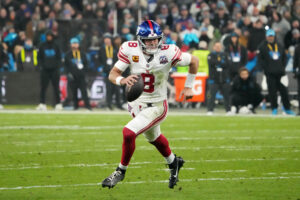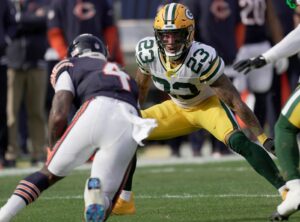Prior to the start of the Carolina Panthers’ three-day, mandatory mini-camp, it was announced that Cam Newton would throw during practices. The 30-year-old quarterback had not thrown publicly since the Week 15 loss against the New Orleans Saints last season. Coming off of arthroscopic surgery on his throwing shoulder, Newton throwing was significant health-wise, as well as the fact that reports also indicated that the 2015 NFL MVP was set to unveil a massive change in his throwing mechanics.
Cam Newton Changes Throwing Motion
Change in Weight Distribution
Perhaps the biggest knock on Newton is his tendency to throw off his back foot. Simply put, most of his body weight is shifted to his back foot as he releases the ball. This motion creates a bit of an unequal weight distribution, which can affect a quarterback’s accuracy, as well as his ability to drive the ball downfield. In Newton’s case, he has enough brute strength that he can still drive the ball, even with his momentum moving backwards. However, he has been criticized for his inaccuracy at times, as well as the fact that throwing off the back foot can put extra stress on the muscles and tendons within the shoulder. In fact, the stress put onto his surgically-repaired right shoulder is a huge reason for the change in mechanics.
This video, from the 2011 NFL Combine, provides a good angle showing Newton's tendency to release the ball with his weight largely on his back foot. His new motion is designed to shift the majority of his weight towards the front foot. pic.twitter.com/3m5Lz7P0iO
— Luke Tucker (@luketucker19_) June 12, 2019
As part of Newton’s new mechanics, he is now releasing the ball further toward his front foot, without ever really shifting his entire weight to the back foot. He’s releasing the ball with a different weight distribution that should not only help with accuracy but should also be beneficial to his health. By throwing off of his front foot, his arm is moving in the same direction as his momentum, which theoretically should put less stress on the shoulder. Shoulder health has been a significant concern for Newton after his 2018 season was ended because of a shoulder injury, as well as the fact that he’s rehabbing his second shoulder surgery in the past three years.
Here is Newton's "unveiled" motion, and you can see he's standing much taller with more weight out front. pic.twitter.com/gPvjjnHt5e
— Luke Tucker (@luketucker19_) June 12, 2019
Change in Arm Slot
The second major change in Newton’s motion is his arm slot. Up until this point in his career, his throwing motion has included a lower arm slot with somewhat of a twist at the elbow. Then as the arm comes forward, the elbow twists back, and the shoulder snaps forward, releasing the ball at about the height of Newton’s head.
This clip shows Newton's "old" arm slot. His arm slot is much lower with the old mechanics, as the new attempts to get Cam to throw more over the top. pic.twitter.com/Fiuo7MviWs
— Luke Tucker (@luketucker19_) June 12, 2019
With the new mechanics, Newton is throwing more over the shoulder instead of the old, snappy, sidearm-type motion. This gives him a higher release point, which is better for his elbow and shoulder health. Throwing over the top leaves less opportunity for mechanical error, as well as simplifying the motion to a more traditional style. This should help Newton throw with more control, as well as creating a more efficient motion that is beneficial to his health.
With the new mechanics, you can see the arm slot is higher, which should reduce stress put on the elbow and rotator cuff, allowing Cam's shoulder to stay healthier. https://t.co/P1NT3Gkudr
— Luke Tucker (@luketucker19_) June 12, 2019
Last Word On Cam Newton
Newton’s return to the field is first and foremost a sign of good health. The fact that he has resumed throwing is a significant step in his rehab. Aside from being healthy is the impact that the new mechanics will have on the former MVP. Newton’s new motion includes him finishing throws with his weight out front, as well as a higher arm slot that should reduce stress in his throwing arm. While Newton will continue working on his new mechanics throughout the off-season, it will be very interesting to see how he responds when the pocket collapses and he’s forced to throw under pressure. Only then will we really see just how entrenched the new mechanics are.






